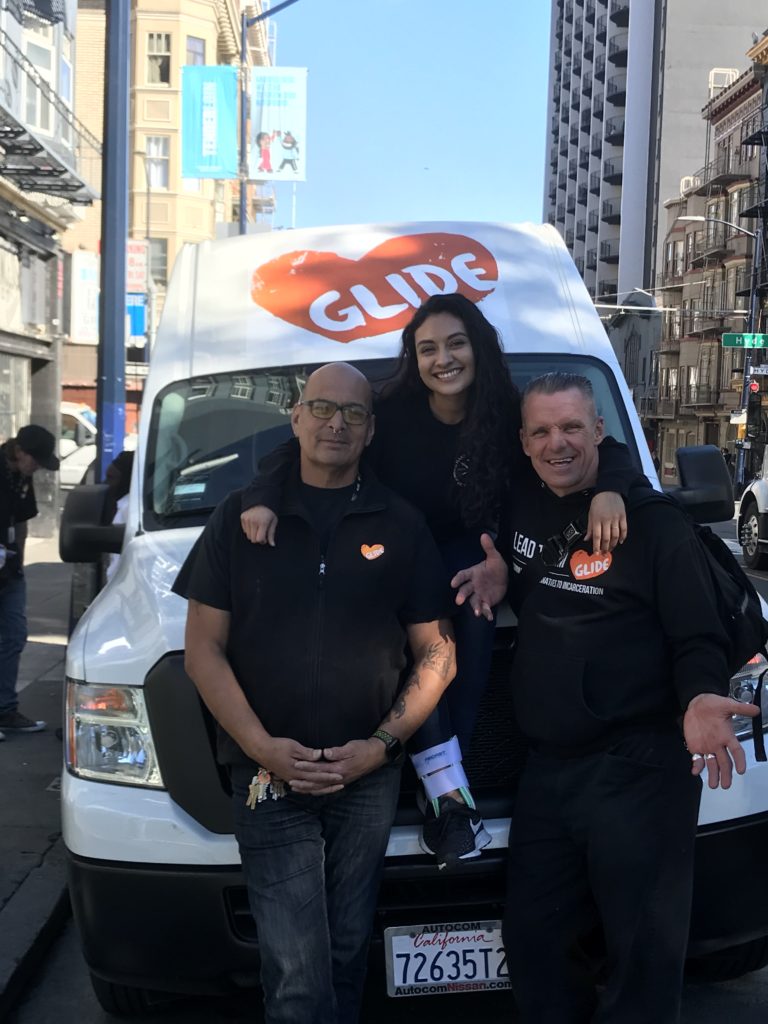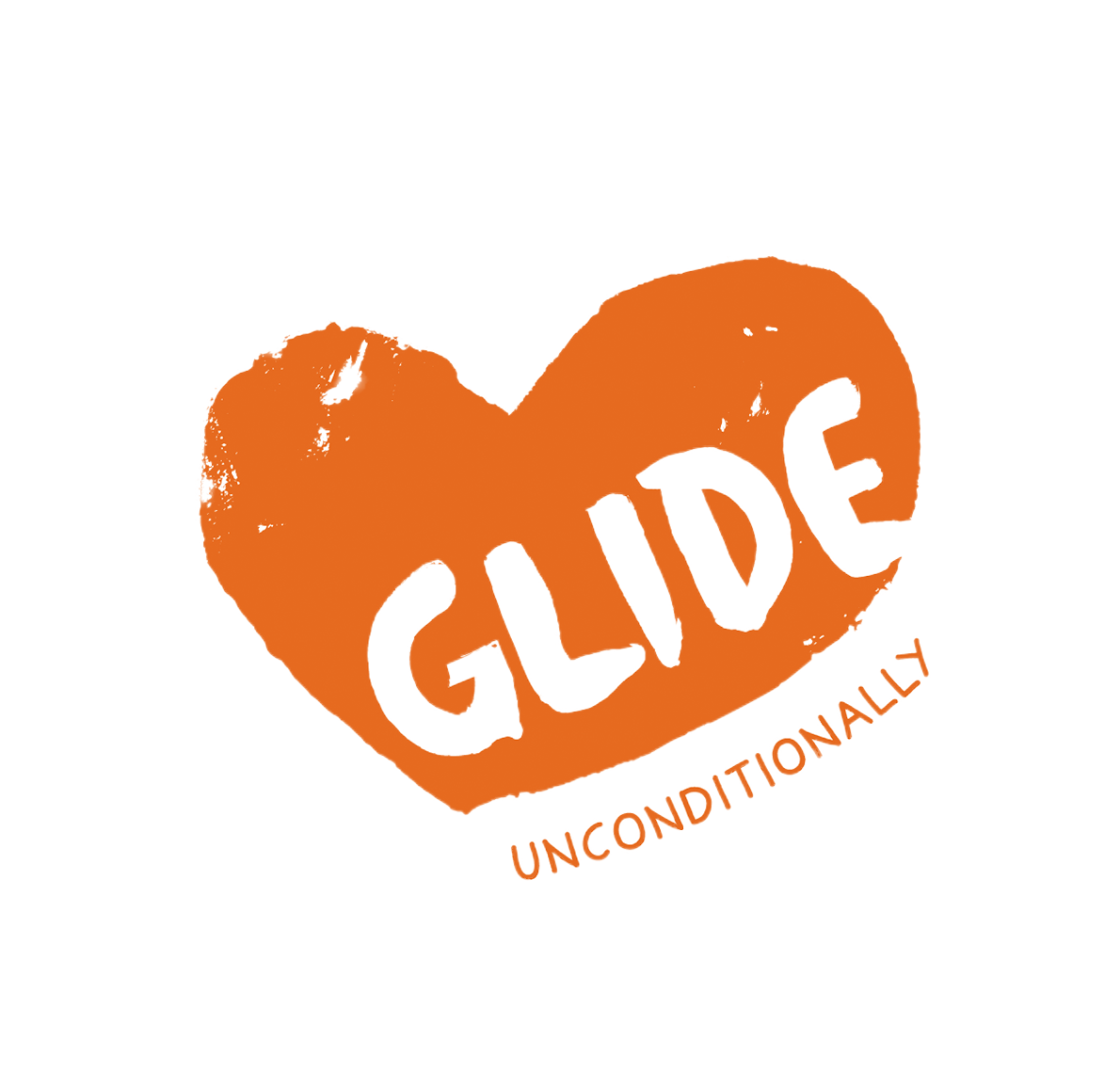A lifeline in a landscape stalked by poverty and the coronavirus
As most of San Francisco remains at a relative standstill to slow the spread of the coronavirus, GLIDE Harm Reduction Case Manager Felanie Castro is behind the wheel, crisscrossing the city seven hours a day.
Piloting GLIDE’s community outreach van, and accompanied by a rotating roster of GLIDE health systems navigators and other Harm Reduction staff (Rita Bagnulo, Ali Lazarus, Jason Norelli, Amy Rodriguez, Amber Sheldon, Mike Thompson), Felanie makes between 20 and 35 stops a day, supporting unhoused San Franciscans for whom social isolation and resource scarcity have only deepened in the context of the current public health emergency.
“Everybody I’m seeing is getting a meal and water, and if they have any SAS [Syringe Access Services] needs, they’re getting that,” explains Felanie during a recent phone conversation.
“I’m also screening people—asking them if they’re having a new cough, experiencing a fever, having shortness of breath. I have a non-contact thermometer that DPH [San Francisco Department of Public Health] gave me. And I’m passing out tents. I think I’ve passed out over 400 tents since the 25th of March. I’m passing out hand sanitizer and hygiene kits. Masks when I get them.”
In practice, mobile outreach is nothing new to Felanie and her Harm Reduction colleagues. GLIDE introduced its customized community outreach van—complete with a phlebotomy chair and other equipment for on-site testing—last year as part of a new program called OPT-IN.
OPT-IN, part of a five-year grant operated in partnership with DPH, is designed to further the reach of GLIDE’s Harm Reduction program in serving the most marginalized populations across San Francisco with successful health interventions for addressing the HIV and Hep C epidemics and other harms among the city’s unhoused residents.
But in the context of a global pandemic—and the necessary scaling back or shuttering of restaurants and most other businesses, all in-person cultural events and many city services—priorities have shifted. More than ever, Felanie and crew act as a literal lifeline to people living an increasingly precarious existence in makeshift encampments and enclaves that fan out from the city center—from SoMa and the Mission to Excelsior, Potrero Hill, Bayshore, Bayview Hunters Point, all the way to the far side of Candlestick Park and beyond to the water’s edge.
“I’ve seen over 2,400 people since the end of March. Distributed over 2,000 meals,” recounts Felanie.
“There are 10 to 15 locations a day that I visit all the time. I’ve been to certain places where they’re saying, ‘Thank you, because you’re the only person coming out here. You’re the only person to ever come out here. And you’re repeatedly coming out here.’”
“The distribution of water and hygiene kits is a critical intervention to prevent disease transmission among persons with no access to running water, such as in the Warehouse district,” adds Harm Reduction Program Manager Daniela Wotke.
In addition to basic necessities and harm reduction services, information has been another valuable offering to help guard the health of people living unhoused.
“I’ve been passing out some literature, too. Little half-page booklets. Dispelling some of the myths that they have,” says Felanie of the people living outside.
“It’s still abstract for a lot of people who are already kind of remote. I’m also giving them the information about MSC South. There are a lot of people who tested positive at MSC South. There are probably people who are positive who were at MSC South and who are out in the community. So physical distancing and having a mask are really things to pay attention to.
“I’m really good with boundaries,” continues Felanie. “I’m wearing my mask; I ask people to keep their distance. So, I lead by example in that respect. Different pockets have different levels of anxiety and stress over this—all coupled with their stress about, ‘Hey, how am I going to get food and water, and basic things to clean myself with, if you don’t come out?’”
To date, no one Felanie has screened for symptoms presented signs that would necessitate further evaluation at SF General. “I haven’t had anybody yet,” notes Felanie, “and I’ve screened maybe 350 people.”

Fortunately, regular services like the ones offered from the OPT-IN van, including the basics of food and water and modest shelter, mean many unhoused city residents have the ability to shelter where they are without having to risk venturing into the more congested centers of town.
And, as Felanie makes clear, the outreach is a community effort:
In addition to logistical support from DPH, and the regular SAS outreach conducted by San Francisco AIDS Foundation (another member of the OPT-IN program), GLIDE’s OPT-IN team relies on a network of allies for sourcing such critical supplies as tents (Coalition on Homelessness), hand sanitizer (via homeless rights activist Christin Evans), meals (GLIDE’s Daily Free Meals team, with donations from Gate Gourmet and others), hygiene kits (The Sisters of Perpetual Indulgence), and masks (some homemade ones, some from a local drive instigated by District 6 Supervisor Matt Haney, to which many generous individuals contributed).
For now, the OPT-IN mobile outreach remains a vital and, for many, a unique line of support as unhoused people across the city weather a season of increased deprivation, uncertainty and risk.
“When you talk about Market Street all the way to the water on the East side, I can’t think of a street that I have not been on,” says Felanie. “There was one or two days when I was between Bayshore and the water all day. I put 50 miles on the van, just in that area. That’s going every single block.”
